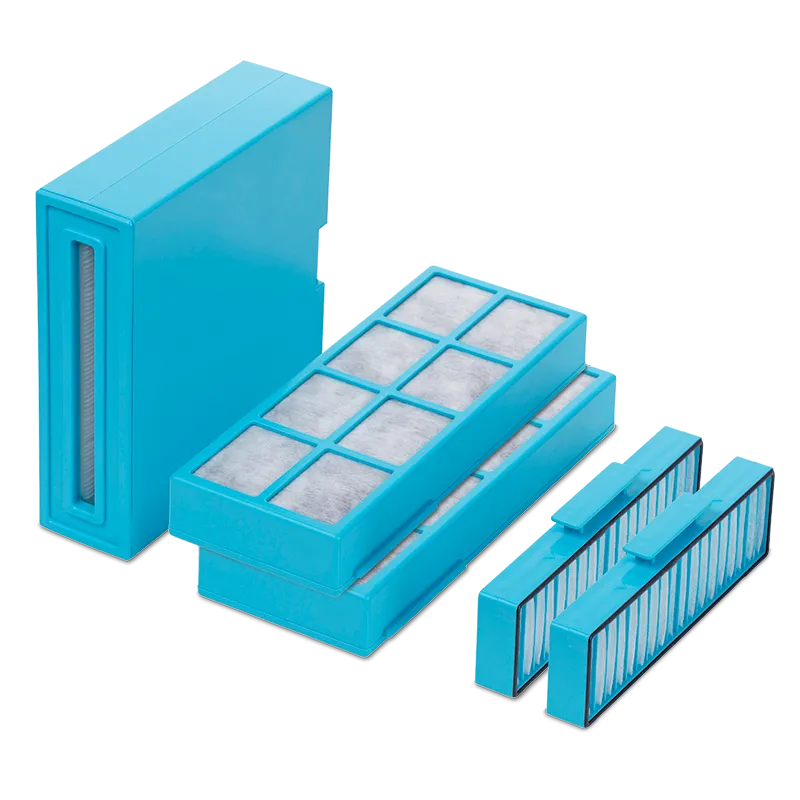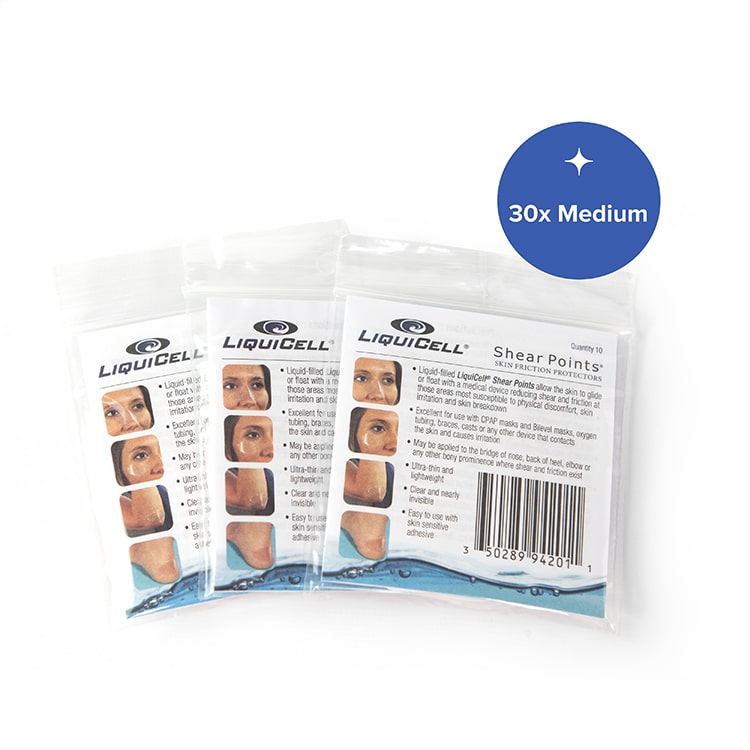Air Purifier for Dust
Dust contains a variety of substances. The solid particles that comprise dust can be inorganic substances, like tiny fragments of minerals.1
Dust can also be composed of organic material such as pet dander, small pieces of soil, or plant matter. An air purifier for dust can capture both organic and inorganic matter and remove it from the air.
SoClean 3-Stage Air Purifier+
Quality of Air
The United States Environmental Agency publishes information about air quality using an Air Quality Index (AQI). As an airborne pollutant, dust falls into the category of particulate matter, as dust particles range in size from 0.1 microns to 10 microns.2 The AQI includes two categories of particulate sizes, 2.5 microns and 10 microns.3 Just 50 millionths of a gram of 2.5-micron particles per cubic meter is enough for the EPA to recommend that healthy adults avoid prolonged exposure. Unfortunately, indoor air quality can easily range into the realm of the unhealthy.4
An air purifier for indoor use can greatly reduce the amount of airborne particulate matter. A HEPA filter, or High Efficiency Particulate Air filter, removes 99.97% of particulate matter that is 0.3 microns in size. Significantly, this is the amount removed of the MPPS, or most penetrating particle. This means that a HEPA filter actually removes more than 99.97% of particles both larger and smaller than 0.3 microns in diameter, making a HEPA filter an effective air purifier for dust. ULPA filters, or Ultra Low Particulate Air filters, remove 99.999% of 0.3-micron particles, and make even greater reductions of particles larger and smaller than that size.
While air purifiers with HEPA and ULPA filters can remove the vast majority of the dust in the air that passes through their air filtration systems, there is only so much air that an air purifier can filter per minute. If new particles enter the air faster than they can be removed, there will not be a net reduction in dust. The same applies for any material the air purifier is designed to remove. This is why, when selecting an air purifier for dust, an air purifier for chemicals, an air cleaner for mold, or an air purifier for any use, the size of the space to be purified needs to be taken into account.
SoClean 3-Stage Air Purifier+
Shop NowDust Inhalation
The specific negative consequences of dust inhalation depend on the content of the dust, but above a certain threshold it is harmful to inhale any type of dusty air.5 This is why it is important to try to reduce sources of dust and mitigate the production of particulate matter indoors. An air purifier for dust can significantly reduce the amount of overall airborne particles, including pathogens like bacteria, viruses, and molds.
More Products from SoClean
SoClean Air Purifier+ Filter Kit
$149
Portable Outlet CPAP Backup Battery V2
Save $50!
New and improved model - when the power goes out, your CPAP stays on!
Just plug the new Portable Outlet UPS between your CPAP equipment and your bedside wall socket to protect from loss of power due to storms or outages.
$349
LiquiCell Shear Points, 30 Skin Friction Protectors, Medium
Great for use anywhere skin would benefit from cushioning and protection. Ultra-thin, liquid-filled strips protect skin and stay in place.
FSA/HSA eligible LiquiCell Shear Points are latex-free, ultrathin, clear liquid-filled membranes that provide a synthetic, external cushion. It reduces painful friction by allowing an object to glide or float over the skin. Gentle skin adhesive keeps LiquiCell Shear Points securely in place overnight, while allowing easy and painless removal in the morning.
Medium, 30 per box, each 2.75" wide by 1.3" high
Also available: Small (30 per box, each 2.2" wide by 1.1" high) LiquiCell Shear Points are excellent for use on the bridge of the nose to reduce irritation from sleep equipment such as face masks.
$19.95
FAQs
Airborne dust ranges in size from 0.1 microns to 10 microns in diameter.6 HEPA filters and ULPA filters remove the vast majority of particles in this size range. An air purifier or electric air cleaner with a HEPA or ULPA filter will be very effective at removing dust from the air.
An air filter can take dust out of the air. Air purifiers fitted with an air filter will be able to remove dust as well. Some HVAC systems include a pre-filter that removes dust from the air before the air gets heated, cooled, or dehumidified. This protects the heating, cooling, or dehumidifying equipment from being damaged by the dust.
So long as the area around the air purifier is free of obstructions, placing an air purifier on a table should not present any problems. Keep in mind that the air purifier might be rather heavy, and as such should be treated like any other appliance when placed in a high place.
If you suspect that there is a source of asbestos in the air, do not rely on an air purifier to remove it. Asbestos causes life-threatening or debilitating illnesses not only in occupational settings, but also in casual exposure.7 Mesothelioma, asbestosis, lung cancer, and other illnesses are serious illnesses caused by asbestos exposure.8 If you suspect there is a source of asbestos, you should contact a professional assessment and removal service.
Why SoClean
Keep your home fresh and SoClean with the SoClean 3-Stage Air Purifier+. Up to 3,000 times more efficient than HEPA standards, the SoClean 3-Stage Air Purifier captures particles down to 10 nanometers and generates cleanroom-level clean air for your home. The easy-to-use design makes it simple to produce quality air wherever you are.
Master Air Purifier Sources:
Air quality sources: Air purification/filtration process sources: HEPA, UPLA, and MERV filter sources:
https://www.smu.edu.sg/sites/default/files/economics/shea2014/presentation/pollution_talk_april_2014_ham2.pdf
https://www.airnow.gov/aqi/aqi-basics/
https://www.ncbi.nlm.nih.gov/pmc/articles/PMC4484965/
https://www.sciencedirect.com/science/article/abs/pii/S0048969701007653
https://www.cfp.ca/content/57/8/881/tab-figures-datad1
https://ehp.niehs.nih.gov/doi/full/10.1289/ehp.1002255
https://www.gotopac.com/art-cr-iso-cleanroom-classifications
https://www.researchgate.net/publication/316472615_A_review_of_air_filtration_technologies_for_sustainable_and_healthy_building_ventilation
https://www.epa.gov/indoor-air-quality-iaq
https://www.airnow.gov/sites/default/files/2020-05/aqi-technical-assistance-document-sept2018.pdf
https://www.health.ny.gov/environmental/indoors/air/pmq_a.htm#:~:text=Exposure%20to%20fine%20particles%20can,as%20asthma%20and%20heart%20disease
https://www.epa.gov/sites/production/files/2018-07/documents/residential_air_cleaners_-_a_technical_summary_3rd_edition.pdf
https://www.ncbi.nlm.nih.gov/pmc/articles/PMC6272289/
https://link.springer.com/article/10.1007%2Fs100220100046
https://www.kompareit.com/homeandgarden/hvac-compare-central-air-cleaner-cost.html
https://www.chemviron.eu/products/activated-carbon/
https://www.who.int/occupational_health/publications/en/oehairbornedust3.pdf
https://academic.oup.com/jimb/article/32/7/319/5992784?login=true
https://www.cabotcorp.com/solutions/products-plus/activated-carbon
https://www.sciencedirect.com/science/article/abs/pii/S009167499970391X
https://www.tandfonline.com/doi/full/10.3109/02770903.2014.895011
https://www.ashrae.org/file%20library/about/position%20documents/filtration-and-air-cleaning-pd.pdf
https://www.britannica.com/science/human-respiratory-system/The-mechanics-of-breathing
https://www.epa.gov/pm-pollution/particulate-matter-pm-basics
https://www.merriam-webster.com/dictionary/HEPA
https://www.standards.doe.gov/standards-documents/3000/3020-astd-2015
https://www.standards.doe.gov/standards-documents/3000/3020-astd-2015/@@images/file
https://www.sciencedirect.com/science/article/abs/pii/S0195670105005074
https://www.ncbi.nlm.nih.gov/pmc/articles/PMC1477932/
https://pediatrics.aappublications.org/content/127/1/93.short
https://www.tandfonline.com/doi/full/10.1080/02786820500191348
https://www.sciencedirect.com/science/article/abs/pii/0360128583900023
https://onlinelibrary.wiley.com/doi/abs/10.1002/ajim.4700270302
https://www.laboratory-supply.net/blog/difference-between-a-hepa-and-ulpa-filter/
https://www.sciencedirect.com/science/article/abs/pii/S0360132320305588
https://www.karger.com/Article/Abstract/151502
https://www.grainger.com/know-how/equipment-information/kh-what-is-merv-rating-air-filter-rating-chart
https://www3.epa.gov/ttn/catc/dir1/ff-hepa.pdf
https://www.epa.gov/indoor-air-quality-iaq/what-merv-rating-1
ttp://gttlab.com/uploads/soft/161025/EN1822-5-2009Highefficiencyairfilters(EPA,HEPAandULPA)Part5Determiningtheefficiencyoffilterelements.pdf
Sources:
- https://web.archive.org/web/20160205001600/http://www.ccohs.ca/oshanswers/chemicals/lungs_dust.html
- https://www.ashrae.org/file%20library/technical%20resources/covid-19/si_s16_ch29aircleanersforparticulates.pdf
- https://www.airnow.gov/sites/default/files/2020-05/aqi-technical-assistance-document-sept2018.pdf
- https://www.tandfonline.com/doi/full/10.1080/26395940.2020.1728198
- https://www.nejm.org/doi/full/10.1056/NEJMoa073625
- https://www.ncbi.nlm.nih.gov/pmc/articles/PMC3499908/
- http://www.arac.co.za/ara1/wp-content/uploads/2017/03/Exposure-Report.pdf










